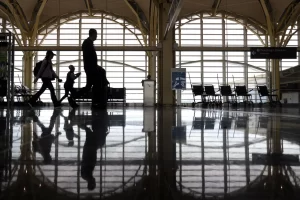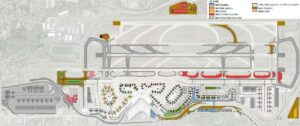Announcement comes on the heels of Airport Director’s exit In a move that has caught community advocates and city representatives off guard, the Port of Seattle has closed the upcoming StART (SEA Stakeholder Advisory Round Table) meeting to the public — a first for the advisory body since its creation in 2018. This meeting, scheduled
Puget Sound Clean Air activates North Sea-Tac Air Quality Monitoring Station
Take a tour of the first fixed-site UFP system near Sea-Tac Airport Puget Sound Clean Air Agency (PSCAA) recently activated the first fixed site air quality monitoring station near Sea-Tac Airport designed to monitor aviation emissions. As of this week it is now on-line and providing data! The station is the twin of a site
The wing tip of an American Airlines plane strikes another aircraft at a DC airport
By OLIVIA DIAZ Updated 4:04 PM PDT, April 10, 2025 The wing tip of an American Airlines plane struck another plane from the same airline on a taxiway of the Ronald Reagan Washington National Airport on Thursday, authorities said. No injuries were reported. The wing tip of an aircraft heading to Charleston, South Carolina, struck a
U.S. Withdraws from Critical IMO Climate Meeting, Threatens Retaliation Over Emissions Pricing
Mike Schuler In a dramatic development at the International Maritime Organization’s (IMO) Marine Environment Protection Committee meeting in London, the Trump administration has announced the United States’ withdrawal from crucial maritime decarbonization negotiations taking place this week. The US government delivered a strongly worded message to IMO delegations, explicitly rejecting any measures that would impose
Port Commission approves $1.9M in Economic Development Grants
But are Airport Communities really being served? At today’s Port of Seattle Commission meeting, the Port approved the 2025–2026 Economic Development Partnership Program — allocating up to $1.9 million in funding for economic initiatives in cities throughout King County. Agenda Packet While the Port frames this as a generous regional investment, a closer look
Port of Seattle asks court to overturn City Council’s Sodo housing bill
by David Kroman Seattle Times staff reporter The Port of Seattle is petitioning a judge to overturn Seattle’s recently passed rezone to allow housing on the edges of the city’s industrial district. The port’s main argument is the city’s legislation almost entirely benefits one person, Chris Hansen, who owns the parcels near T-Mobile Park that are most
Port of Seattle Providing Notice to Individuals Affected by Fall 2024 Cyberattack
The Port of Seattle (the “Port”) announced today notification letters are being mailed to individuals whose data was impacted in the August 2024 cyberattack on the Port, including Seattle-Tacoma International Airport (SEA) and maritime facilities. The threat actors accessed and downloaded some personal information from previously used Port systems for employee, contractor, and parking data.
Green Methanol: A Deep Dive into the Alternative Marine Fuel
By Jack Winterhalter, Washington Sea Grant Hershman Fellow Fuel burned by oceangoing vessels — large ships that carry marine cargo and passengers around the world — contributes about 3% of total greenhouse gas (GHG) emissions globally. Most oceangoing vessels in operation use petroleum-based fossil fuels that release greenhouse gas emissions and other air pollutants that
Status Report 2025 Q1 Part 2 (State and Local)
Where we’re at. What you can do. We’ve gotten questions regarding “where does everything stand?”, including the Sustainable Airport Master Plan (SAMP), state legislation, local government and how it all fits together. In Part I, we discussed the SAMP, today we’ll talk about state and local affairs. Government State Both major bills we supported, SB5652
Status Report Q1 2025 Part 1 (SAMP)
Where we’re at. What you can do. We’ve gotten questions regarding where the Sustainable Airport Master Plan (SAMP) is at, state legislation, and possible next steps. We’ll start with the SAMP today, where we don’t know a lot and go into the state and local affairs next time. The SAMP NEPA Draft EA The NEPA








